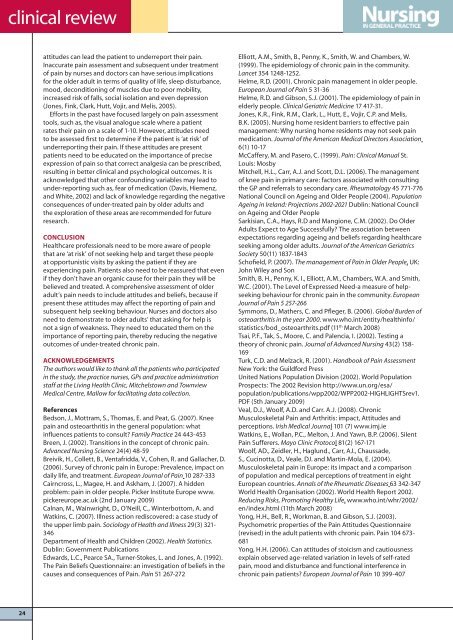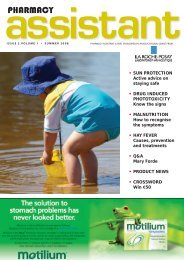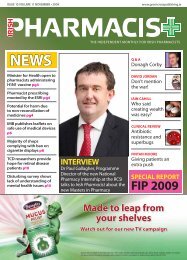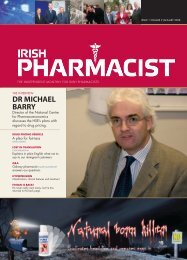veNTIlATIoN - Green Cross Publishing
veNTIlATIoN - Green Cross Publishing
veNTIlATIoN - Green Cross Publishing
You also want an ePaper? Increase the reach of your titles
YUMPU automatically turns print PDFs into web optimized ePapers that Google loves.
clinical review<br />
24<br />
attitudes can lead the patient to underreport their pain.<br />
Inaccurate pain assessment and subsequent under treatment<br />
of pain by nurses and doctors can have serious implications<br />
for the older adult in terms of quality of life, sleep disturbance,<br />
mood, deconditioning of muscles due to poor mobility,<br />
increased risk of falls, social isolation and even depression<br />
(Jones, Fink, Clark, Hutt, Vojir, and Melis, 2005).<br />
Efforts in the past have focused largely on pain assessment<br />
tools, such as, the visual analogue scale where a patient<br />
rates their pain on a scale of 1-10. However, attitudes need<br />
to be assessed first to determine if the patient is ‘at risk’ of<br />
underreporting their pain. If these attitudes are present<br />
patients need to be educated on the importance of precise<br />
expression of pain so that correct analgesia can be prescribed,<br />
resulting in better clinical and psychological outcomes. It is<br />
acknowledged that other confounding variables may lead to<br />
under-reporting such as, fear of medication (Davis, Hiemenz,<br />
and White, 2002) and lack of knowledge regarding the negative<br />
consequences of under-treated pain by older adults and<br />
the exploration of these areas are recommended for future<br />
research.<br />
coNclusIoN<br />
Healthcare professionals need to be more aware of people<br />
that are ‘at risk’ of not seeking help and target these people<br />
at opportunistic visits by asking the patient if they are<br />
experiencing pain. Patients also need to be reassured that even<br />
if they don’t have an organic cause for their pain they will be<br />
believed and treated. A comprehensive assessment of older<br />
adult’s pain needs to include attitudes and beliefs, because if<br />
present these attitudes may affect the reporting of pain and<br />
subsequent help seeking behaviour. Nurses and doctors also<br />
need to demonstrate to older adults’ that asking for help is<br />
not a sign of weakness. They need to educated them on the<br />
importance of reporting pain, thereby reducing the negative<br />
outcomes of under-treated chronic pain.<br />
AcKNowledgemeNTs<br />
The authors would like to thank all the patients who participated<br />
in the study, the practice nurses, GPs and practice administration<br />
staff at the Living Health Clinic, Mitchelstown and Townview<br />
Medical Centre, Mallow for facilitating data collection.<br />
references<br />
Bedson, J., Mottram, S., Thomas, E. and Peat, G. (2007). Knee<br />
pain and osteoarthritis in the general population: what<br />
influences patients to consult? Family Practice 24 443-453<br />
Breen, J. (2002). Transitions in the concept of chronic pain.<br />
Advanced Nursing Science 24(4) 48-59<br />
Breivik, H., Collett, B., Ventafridda, V., Cohen, R. and Gallacher, D.<br />
(2006). Survey of chronic pain in Europe: Prevalence, impact on<br />
daily life, and treatment. European Journal of Pain 10 287-333<br />
Cairncross, L., Magee, H. and Askham, J. (2007). A hidden<br />
problem: pain in older people. Picker Institute Europe www.<br />
pickereurope.ac.uk (2nd January 2009)<br />
Calnan, M., Wainwright, D., O’Neill, C., Winterbottom, A. and<br />
Watkins, C. (2007). Illness action rediscovered: a case study of<br />
the upper limb pain. Sociology of Health and Illness 29(3) 321-<br />
346<br />
Department of Health and Children (2002). Health Statistics.<br />
Dublin: Government Publications<br />
Edwards, L.C., Pearce SA., Turner-Stokes, L. and Jones, A. (1992).<br />
The Pain Beliefs Questionnaire: an investigation of beliefs in the<br />
causes and consequences of Pain. Pain 51 267-272<br />
Elliott, A.M., Smith, B., Penny, K., Smith, W. and Chambers, W.<br />
(1999). The epidemiology of chronic pain in the community.<br />
Lancet 354 1248-1252.<br />
Helme, R.D. (2001). Chronic pain management in older people.<br />
European Journal of Pain 5 31-36<br />
Helme, R.D. and Gibson, S.J. (2001). The epidemiology of pain in<br />
elderly people. Clinical Geriatric Medicine 17 417-31.<br />
Jones, K.R., Fink, R.M., Clark, L., Hutt, E., Vojir, C.P. and Melis,<br />
B.K. (2005). Nursing home resident barriers to effective pain<br />
management: Why nursing home residents may not seek pain<br />
medication. Journal of the American Medical Directors Association<br />
6(1) 10-17<br />
McCaffery, M. and Pasero, C. (1999). Pain: Clinical Manual St.<br />
Louis: Mosby<br />
Mitchell, H.L., Carr, A.J. and Scott, D.L. (2006). The management<br />
of knee pain in primary care: factors associated with consulting<br />
the GP and referrals to secondary care. Rheumatology 45 771-776<br />
National Council on Ageing and Older People (2004). Population<br />
Ageing in Ireland: Projections 2002-2021 Dublin: National Council<br />
on Ageing and Older People<br />
Sarkisian, C.A., Hays, R.D and Mangione, C.M. (2002). Do Older<br />
Adults Expect to Age Successfully? The association between<br />
expectations regarding ageing and beliefs regarding healthcare<br />
seeking among older adults. Journal of the American Geriatrics<br />
Society 50(11) 1837-1843<br />
Schofield, P. (2007). The management of Pain in Older People. UK:<br />
John Wiley and Son<br />
Smith, B. H., Penny, K. I., Elliott, A.M., Chambers, W.A. and Smith,<br />
W.C. (2001). The Level of Expressed Need-a measure of helpseeking<br />
behaviour for chronic pain in the community. European<br />
Journal of Pain 5 257-266<br />
Symmons, D., Mathers, C. and Pfleger, B. (2006). Global Burden of<br />
osteoarthritis in the year 2000. www.who.int/entity/healthinfo/<br />
statistics/bod_osteoarthrits.pdf (11 th March 2008)<br />
Tsai, P.F., Tak, S., Moore, C. and Palencia, I. (2002). Testing a<br />
theory of chronic pain. Journal of Advanced Nursing 43(2) 158-<br />
169<br />
Turk, C.D. and Melzack, R. (2001). Handbook of Pain Assessment<br />
New york: the Guildford Press<br />
United Nations Population Division (2002). World Population<br />
Prospects: The 2002 Revision http://www.un.org/esa/<br />
population/publications/wpp2002/WPP2002-HIGHLIGHTSrev1.<br />
PDF (5th January 2009)<br />
Veal, D.J., Woolf, A.D. and Carr. A.J. (2008). Chronic<br />
Musculoskeletal Pain and Arthritis: impact, Attitudes and<br />
perceptions. Irish Medical Journal 101 (7) www.imj.ie<br />
Watkins, E., Wollan, P.C., Melton, J. And yawn, B.P. (2006). Silent<br />
Pain Sufferers. Mayo Clinic Protocol 81(2) 167-171<br />
Woolf, AD., Zeidler, H., Haglund., Carr, AJ., Chaussade,<br />
S., Cucinotta, D., Veale, DJ. and Martin-Mola, E. (2004).<br />
Musculoskeletal pain in Europe: its impact and a comparison<br />
of population and medical perceptions of treatment in eight<br />
European countries. Annals of the Rheumatic Diseases 63 342-347<br />
World Health Organisation (2002). World Health Report 2002.<br />
Reducing Risks, Promoting Healthy Life. www.who.int/whr/2002/<br />
en/index.html (11th March 2008)<br />
yong, H.H., Bell, R., Workman, B. and Gibson, S.J. (2003).<br />
Psychometric properties of the Pain Attitudes Questionnaire<br />
(revised) in the adult patients with chronic pain. Pain 104 673-<br />
681<br />
yong, H.H. (2006). Can attitudes of stoicism and cautiousness<br />
explain observed age-related variation in levels of self-rated<br />
pain, mood and disturbance and functional interference in<br />
chronic pain patients? European Journal of Pain 10 399-407










